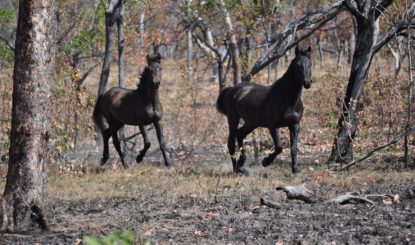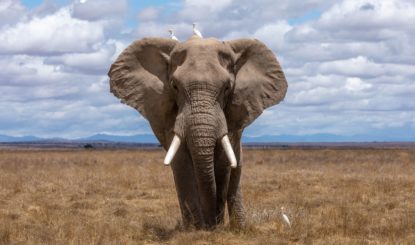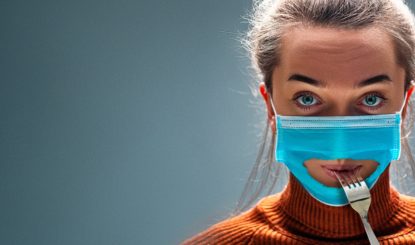Aerial Count Confirms Harmony and Abundant Wildlife on Bonrook
In October 2023, Viktoria Kirchhoff, Project Manager Horse Sanctuaries, and Sam Forwood, Bonrook Station Manager, conducted an aerial count over Bonrook in the Northern Territory, Australia. The results revealed robust numbers, a well-managed ecosystem, and demonstrated the harmonious coexistence of various species.
At this aerial count, Viktoria Kirchhoff, Sam Forwood, and pilot John Armstrong of Agri Muster from Katherine embarked on a 7.5-hour mission in an R44 helicopter, covering the entire expanse of Bonrook in a precise grid pattern. This comprehensive survey, focusing on brumbies, wild cattle, and water buffaloes, spanned over 495 km², covering the 385 km² fenced and the 110 km² unfenced land of Bonrook.
The goal of the meticulous animal count was to gain crucial insights into the wildlife population of the sanctuary. The results of this significant endeavour revealed an enumeration of 759 wild horses (brumbies), 117 wild cattle, and 102 water buffaloes (with an estimated margin of error of about 10%).
Harmonious Balance
The data not only showcase the diverse wildlife thriving at Bonrook but also emphasize a harmonious equilibrium aligning with the official carrying capacity set by the Department of Land. The significance of this census transcends mere numbers; it underscores the well-managed ecosystem at Bonrook. The responsible stewardship of this wild expanse reflects a commitment to sustainability, conservation, and the harmonious coexistence of different species.
Collaboration with Local Aboriginal Community
In close proximity to the fence lines, Viktoria and Sam spotted approximately 50 brumbies on the adjacent land of the Jawoyn People, the local Aboriginal community. Viktoria immediately initiated contact and has since been working with the Jawoyn Association to safely integrate these wild horses into Bonrook. This involves the installation of a total of seven one-way gates strategically placed by Sam along the northern, eastern, and southern fence lines.
Future Monitoring Plans
The remarkable aerial count, the first of its kind at Bonrook, underscores the need for regular monitoring. It is planned to conduct aerial surveys at Bonrook every three to four years to gain ongoing insights into the evolving dynamics of the animal population and enable proactive conservation measures.
As we celebrate the success of this aerial count, Bonrook remains a shining example of animal welfare, responsible management, and the delicate balance between nature and stewardship.
About Bonrook
Acquired by Fondation Franz Weber in 1989, Bonrook stands as the sole wild horse sanctuary in Australia, providing safety for a significant number of brumbies. Located 2.5 hours south of Darwin in the Northern Territory (NT), it offers 495 km² of pasture where wild horses roam freely in their family groups, undisturbed and untamed.
Total number of animals in Bonrook:
Brumbies: 759 (77.6%)
Wild bovines: 117 (12%)
Wild buffaloes: 102 (10.4%)
= Total number of animals surveyed: 978 (100%)
Beehives at Bonrook
In September of last year, Fondation Franz Weber (FFW) received a request from Bee’s Creek Honey. The local honey producer was in search of a temporary location for their beehives at Bonrook, FFW’s wild horse sanctuary in Australia.
Recognizing the importance of this request, FFW provided the honey producer with space for their beehives free of charge for the desired period from November to March of this year.
Bonrook, with its natural bushland landscape, is ideally suited to provide the bees with the best sources of nectar and pollen for their well-being. This is especially crucial during the challenging wet season when it becomes difficult to find enough nectar and pollen through free foraging.
If free foraging is insufficient during this time, artificial feeding becomes necessary. The beekeeper would then have to artificially feed their bee colonies with pollen supplements and sugar water. While the use of pollen supplements is unproblematic, feeding of sugar water leads to bees storing it in their combs. This accumulation of sugar syrup in the beehive prevents honey extraction. Therefore, locating sites rich in native bushland is considered the optimal approach for bee health during the wet season.
Depending on weather conditions and rainfall, it is planned to relocate the beehives from Bonrook by the end of March this year. This relocation will take place in the early hours of the morning, long before sunrise, to ensure that the bees are resting in the hives and not foraging for food.
The collaboration between Bonrook and Bee’s Creek Honey is another example of Fondation Franz Weber’s commitment to environmental conservation and sustainable beekeeping practices in the unique environment of the Wild Horse Sanctuary in Australia.


